Art at a music festival often degenerates into decoration, but that is certainly not the case for Groningen's CLASH. 'We don't want art to be left out of the programming, but rather to be given full attention. We think it deserves that,' says organiser Milou de Boer. Fifty per cent of CLASH's programming budget goes to the arts, and it showed. A large flapping canvas, a shower of sparks and 14 singing glass bells clashed with the thumping electronic beats and held out - even after midnight when the audience started to get pretty tipsy here and there.
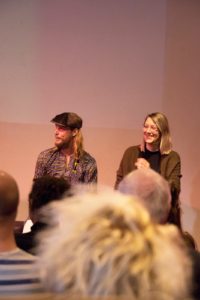
The last edition of CLASH dates from 2011, but three ambitious Groningers ended six years of radio silence this year and breathed new life into the festival. Milou de Boer, Joachim de Vries and Niels Meijer missed a place where visual art and electronic music came together. 'We are missing something in Groningen that makes art interesting in this way for people who don't go to museums very often,' says Meijer. After three pre-parties and last weekend's edition CLASH XXL, CLASH is back.
Art as a total experience
The art at CLASH is not the standard painting on the wall, Meijer explains: 'We are really looking for a total experience.' CLASH takes art away from the museum context. 'We don't leave the art in the usual white cube see,' De Boer adds. However, there is often a nod to that neutral white museum space. De Boer: 'We have very small museum signs everywhere, but in places where you wouldn't normally find them.' At CLASH, for instance, you see museum signs by the socket, by the beer tap or by a fire hose.
Weval postpones climax

Headliner of CLASH, Weval, sold out Amsterdam Paradiso within a few days, there is also a queue at the Grand Theatre. Layer by layer, Weval builds their opening track with seemingly simple motifs. The beat remains off at first: the audience can only watch as the producer duo uses twists and turns of knobs to create a landscape of melodies. With tracks like Gimme some Weval is capable of quickly taking the audience to ecstatic heights, but now they deliberately frustrate the audience. They tease it almost. As befits a good lover, Weval delays the climax. When the beat finally drops, it is gratefully received with cheers.
So that electronic music is all right at CLASH, but do the art installations manage to drown out the fine beats?
'I find it a bit scary'
I decide to investigate it myself and stand in front of a giant orange square at 1am. It is a canvas stretched between a large metal frame. 'This is Flap Flap'' says artist Philip Vermeulen. He says the audience, mostly with a beer in hand, is welcome to come a little closer. The mechanical movements of the pole in the centre of the canvas start Flap Flap to move. At first curious, as if discovering its own freedom of movement, then increasingly confident. Vermeulen himself speaks of a high frequency fuck machine and that observation has not escaped the man next to me, he makes an obscene joke about it. The man in front of me takes a step back and says played to a friend: 'I find it a bit scary'.
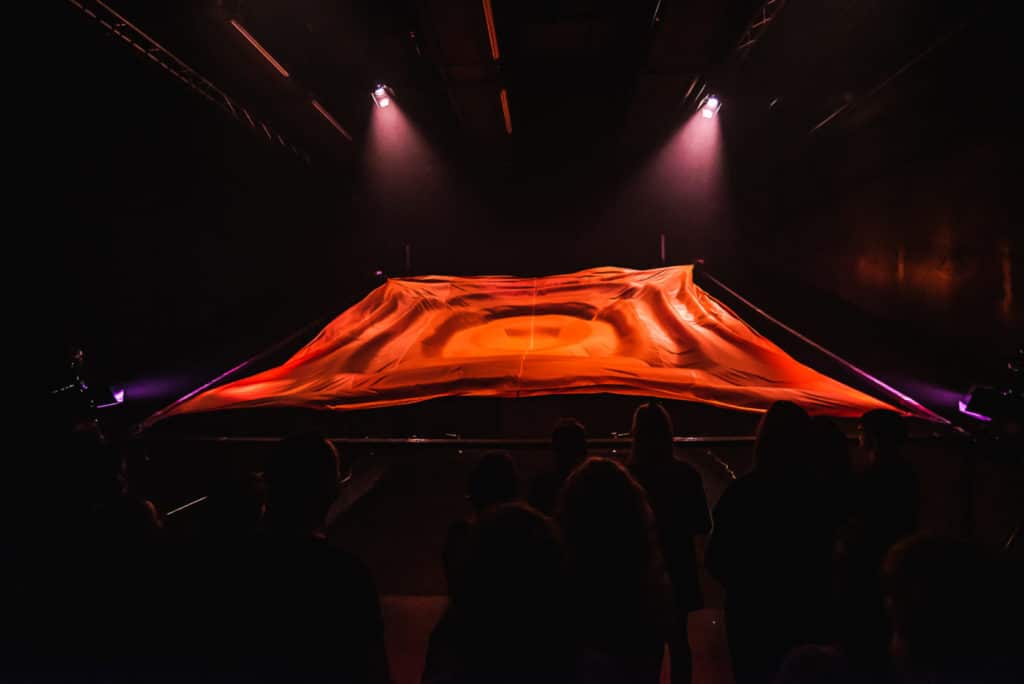
Where the sound of Flap Flap first still has something of a flutter, the installation soon moves so fast that it drowns out the thumping music of the party below with a rattle like a jackhammer. The man in front of me takes another step backwards-not played now. I myself also keep a safe distance: 'what if a point of the canvas comes loose?' It's something Vermeulen consciously plays with, he tells me the next day: 'I try to make my installations in such a way that, as an audience, you don't quite trust them.' With the rapid jerks, there is little left of the square surface, the patterns hypnotise; I see a desert landscape in a storm. When Vermeulen plays with the light, the orange surface seems to glow up like a tropical animal blowing itself up to do a mating dance. The audience cheers.
Set fire to the rain
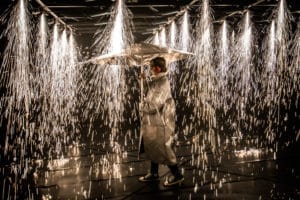
The installation Rain by Pelle Schilling seems similarly dangerous. To enter his installation, the audience must put on soundproof headphones. Rain is a five-by-five-metre installation with twenty-five grinding tools. As a little boy in his father's metal workshop, Schilling marvelled at the shower of sparks created by the welders there. For a brief moment, he lets the audience experience that same wonderment. With tremendous violence, the grinding tools begin to spew fire. A visitor, with iron umbrella and jacket, walks serenely under the violence and we watch the shower of sparks bounce off her.
The beat of trickling water
The line between art and music appears to be slowly blurring at CLASH. In the basement of the VERA and I bump into the less accessible music of Red Brut. Is it music at all, I wonder, isn't this more of a performance? Brut stands behind a table on which cassette tapes are displayed. On each side of the tape is a different sound, recorded by Brut himself. The sound of a drain and a train passing by, she interposes them live improvising. Miraculously, a beat emerges-not a danceable one, but a fascinating one.
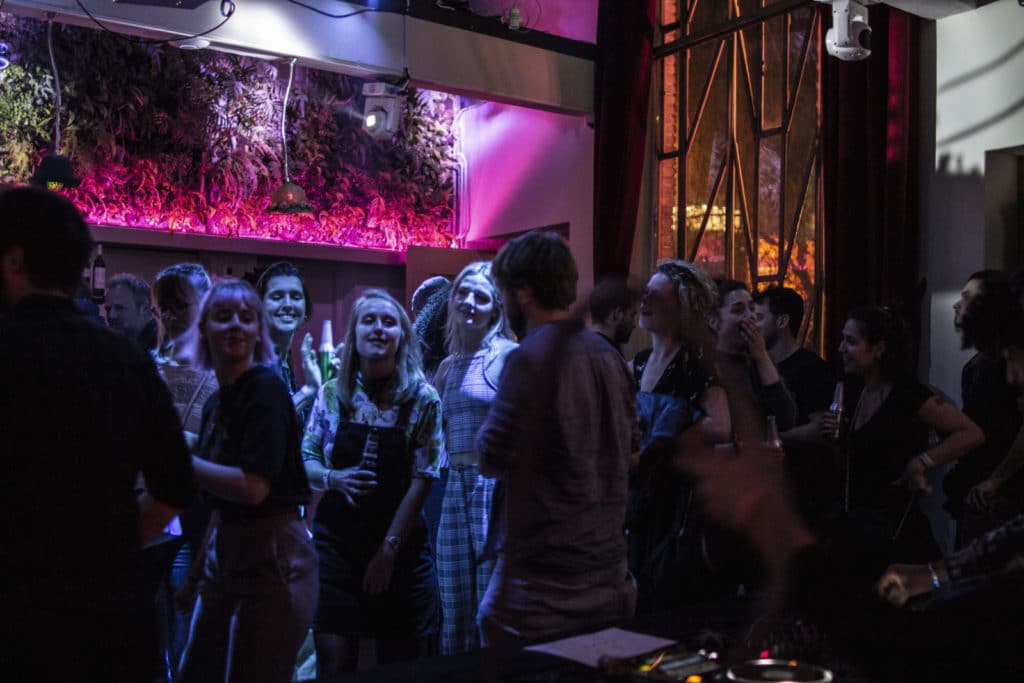
In the Grand Theatre's Foyer, several local DJs spin and the party goes wild. Via the dance floor full of young hip Groningers, I find a place of stillness in the Grand's upstairs room with the film THE VANITY OF VANITIES. Anne Senstad's black-and-white images show a devastating sea, whose waves crash onto ever-changing rocks. In the wild revelry, she reminds us of the temporality and vanity of life. So go back to dancing, because before you know it, it will be over.
Reflection and reflection on Sunday
The second day of CLASH is dedicated to reflection and contemplation. Panel discussions reflect on the intoxication of the previous evening. De Boer: 'We think it is important to be able to reflect on what you have experienced.' The first panel discussion will therefore focus on the art experience. Of particular interest here is the scientific perspective of neuroscientist Iris Sommers. She says that we usually rely on our senses, but art challenges our senses and thus asks us to look again, listen again: 'Art just doesn't fit the picture.' Artist Philip Vermeulen complements her: 'When you go over your senses the beauty kicks in: 'The ego dissolves.'
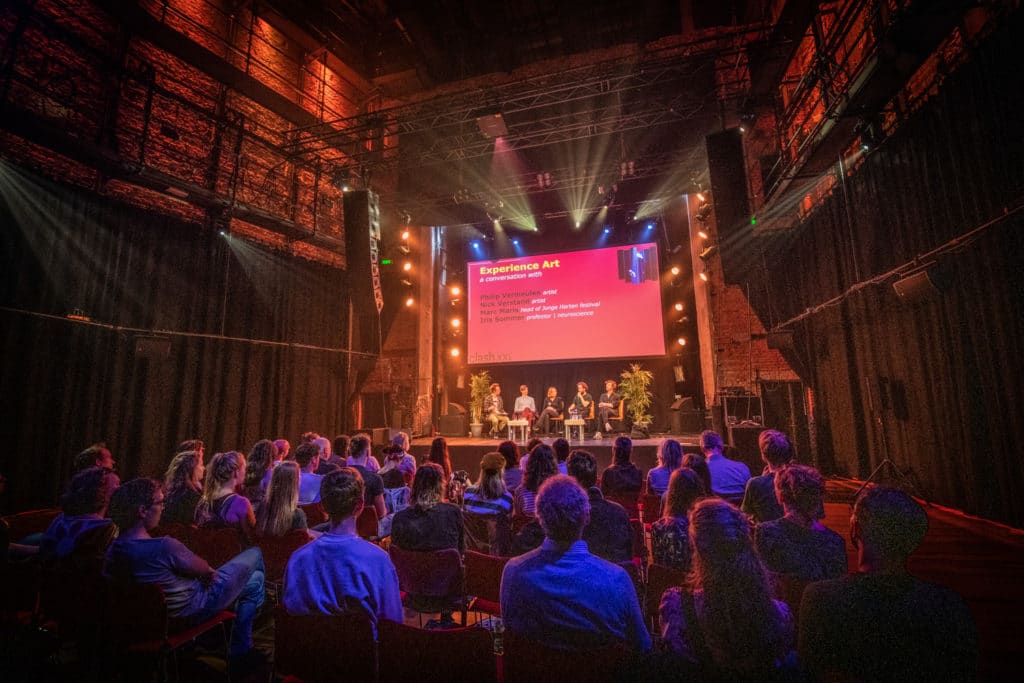
The beauty kicks in
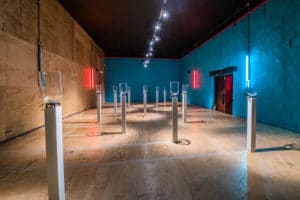
That sounds floaty, were it not that I experienced it myself shortly before at Tune by Bouke Groen: As I walk up the stairs of nightclub Oost, instead of the usually pounding techno, I hear a soft high-pitched chant. Inverted glass bells are arranged in rows on pedestals. In addition to the high notes, there is the soft crackle of the cables connected to the bells. Electric vibrations cause the glasses to start singing. It gives the sound of a finger over crystal wine glass. With 14 at a time, the constant buzzing sounds like the squeak in your ear. It bothers me. I listen until my discomfort disappears, after five minutes I surrender and notice how the sound drowns out my thoughts. In the high tones, I find a place of stillness - no yoga class can beat that.
A critical question
In the panels on Sunday, there seems to be no clash to be; it is a relaxed moment of contemplation. Yet then comes a critical question from the audience. An audience member wonders why there is only one woman on stage. The moderator answers honestly: 'I don't know.' Out of curiosity, I start counting back: where the distribution of art and music is balanced, the number of women is certainly not fifty-fifty. 'I agreed with that critical note from the audience. We are aware of it and we will definitely address it in the future,' De Boer assured me. That TINKEBELL was the closing keynote at least makes up for a lot.
'Art can save the world!'
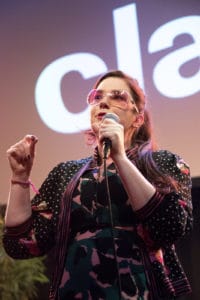
Artist TINKEBELL - indeed, the one with the cat handbag - does not shy away from confrontation.
This makes her the perfect closing act for CLASH: 'If I agree with someone, I say it, if I disagree with something, I shout it. Clash is the story of my life,' she sighs. Her keynote is loose and engaging with plenty of sidelines. There is one clear line: TINKEBELL believes art can save the world. That, she says, is why Thierry Baudet - from whose speech TINKEBELL quotes - thinks the artist is undermining him.
With TINKEBELL's keynote, CLASH ends in a hopeful paean to art. CLASH proves that that art can hold its own even at a music festival and deserves full attention. The next edition will surely not be another six years away.
